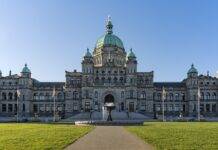IN THE KNOW:
Former 10 to Watch winner among startup competition finalists
Victoria’s Apricell Biotechnology (whose founders are pictured above) is one of 215 finalists vying for $250,000 in prizing in this year’s New Ventures BC Competition.
A Douglas 10 to Watch winner in 2023, Apricell is developing advanced 3D tissue culture models for cancer research and personalized medicine, with a focus on creating human-mimicked tumor models to address the high failure rate of anti-cancer drugs during clinical trials.
The New Ventures BC (NVBC) Competition is B.C.’s largest and longest-running tech competition, designed to support early-stage startups by providing education, mentorship and networking opportunities. The first-place winner receives $80,000, with additional specialty awards valued at $10,000 each.
Since its inception in 2000, NVBC has supported over 4,200 companies that have collectively created thousands of jobs and raised billions in funding. Winners are announced in September.
Tsartlip and Tseycum First Nations sign MOU with CRD
The Capital Regional District (CRD), Tsartlip (W̱JOȽEȽP), and Tseycum (W̱SIḴEM) First Nations have signed a Memorandum of Understanding (MOU) to formalize their government-to-government relationship.
This agreement, facilitated through the W̱SÁNEĆ Leadership Council (WLC), marks a significant step toward reconciliation and collaborative governance. The CRD operates on the traditional territory of the W̱SÁNEĆ people, who have stewarded these lands and waters since time immemorial.
The MOU aims to foster stronger partnerships, enhance communication, and promote mutual respect for governance structures and cultural values. It outlines shared principles for decision-making and sets priority areas for collaboration.
“W̱SÁNEĆ are a strong people, with unique culture, language, and traditional practices. We must continue to work based upon the guidance of our Elders, so that our children have a future to look forward to on their own Territory,” said Chief Tanya Jimmy, Tseycum First Nation.
“The W̱SÁNEĆ Leadership Council, on behalf of W̱JOȽEȽP and W̱SIḴEM, is working directly with the CRD, not because we want to become like municipalities or regional districts, but because local government authorities make decisions over W̱SÁNEĆ Territory, which our people have a responsibility to protect. This responsibility stems from W̱SÁNEĆ ancient laws, created by XÁLS, the Creator. These laws and orders have survived colonization.
I strongly encourage the CRD to advance the United Nations Declaration on the Rights of Indigenous Peoples (UNDRIP) and respect W̱SÁNEĆ Douglas Treaty Rights. This MOU will aid the CRD in doing just that, and in advancing initiatives that will benefit both W̱SÁNEĆ and the general public,” said Chief Don Tom, Tsartlip First Nation, and Chair of the WLC Board.
The agreement is expected to provide tangible benefits to both W̱SÁNEĆ communities and residents throughout the region.
Chamber reacts to amalgamation recommendation
The Victoria-Saanich Citizens’ Assembly says Greater Victoria’s two largest municipalities should merge.
This comes after several months of public engagement in which in which 48 randomly selected residents of Saanich and Victoria explored the costs, benefits and disadvantages of amalgamation. “Members heard from a range of experts and stakeholders, considered an array of issues and questions, drafted a set of values to guide their process, and worked towards consensus on their final recommendations,” said a media release.
Amalgamation would streamline zoning bylaws, regulations, and infrastructure planning, making it easier for businesses to operate across the region without navigating separate municipal rules. Combining Victoria’s and Saanich’s tax bases could create a healthier ratio of 35% business to 65% residential taxes, compared to the current disparities between the two municipalities. This could make the region more attractive for business investment.
An amalgamated municipality with a combined population of over 200,000 would qualify to join national platforms like Canada’s Big Cities Mayor’s Caucus. This could improve access to federal and provincial funding, particularly for infrastructure projects that benefit businesses.
In a newsletter to members, the Greater Victoria Chamber of Commerce applauded the findings. “This is a major win for The Chamber. We’ve literally been advocating for this since the mid-20th Century,” Chamber CEO Bruce Williams said. “When we were packing up to move our office, we found binders with reams of paperwork calling for amalgamation over the decades.”
There are challenges to overcome. While overall tax rates are similar between the two municipalities, differences in service levels (like policing) may lead to debates about how costs are distributed. Businesses in Saanich may face higher taxes if services are leveled up to match Victoria’s.
However many agree a proposed amalgamation has the potential to create a more efficient and competitive economic environment in Victoria and Saanich. The next step will be for the City of Victoria and District of Saanich to review the consensus reached by the Assembly.
“Both municipal councils have committed to receiving the Assembly’s final report and deliberating on its recommendations,” the Assembly report stated. “If they decide to endorse the Assembly’s recommendation for a public referendum on amalgamation, they will work with the Province of British Columbia to initiate it, likely to coincide with the next municipal elections in 2026.”
Credit Union merger announced
Prospera Credit Union, Coast Capital Savings Federal Credit Union, and Sunshine Coast Credit Union will merge into Canada’s largest national purpose-driven credit union.
The combined entity will manage $38.6 billion in assets and serve 730,000 members across 70 branches in British Columbia. The precedent-setting merger will transition Prospera and Sunshine Coast from provincial to federal regulation, aligning them with Coast Capital’s federal status. The move is expected to provide enhanced financial products, digital banking tools, and expanded services for members nationwide.
Voting on the merger will begin shortly, with regulatory approvals expected thereafter. If finalized, this union will position the credit unions as a competitive alternative to major banks while fostering resilience within Canada’s cooperative banking sector.
BC’s procurement strategy adapts to intensifying trade war
In response to the intensifying trade war, Premier David Eby has announced new directives aimed at reducing B.C.’s dependence on American goods and services.
Key measures include reviewing existing contracts with US suppliers to identify alternatives from Canada or other countries, excluding American goods and services in new procurement activities wherever feasible, canceling non-essential government travel to the US and avoiding renewal of memberships in US-based industry associations.
The province has also committed to developing mid- and long-term strategies to support Canadian businesses and diversify trading partnerships.
Premier Eby emphasized the importance of supporting local businesses and building an economy less reliant on US suppliers. These directives are part of a broader effort to align government purchasing power with public sentiment favoring Canadian products
FROM THE PAGES OF DOUGLAS:
Meet the 2025 winners of Douglas magazine’s 10 to Watch Awards, an impressive array of entrepreneurs whose bold ideas could have big impact.
MARK YOUR CALENDAR:
APRIL
April 15: Greater Victoria Chamber of Commerce AGM & US Relations Panel
MAY
May 1: VIATEC Awards
May 4 – 9: International Seaweed Symposium
May 27 – 30: Web Summit
May 30: VIBI Awards
JUNE
June 4: Greater Victoria Chamber of Commerce Business Awards
June 10: TEDxVictoria



























